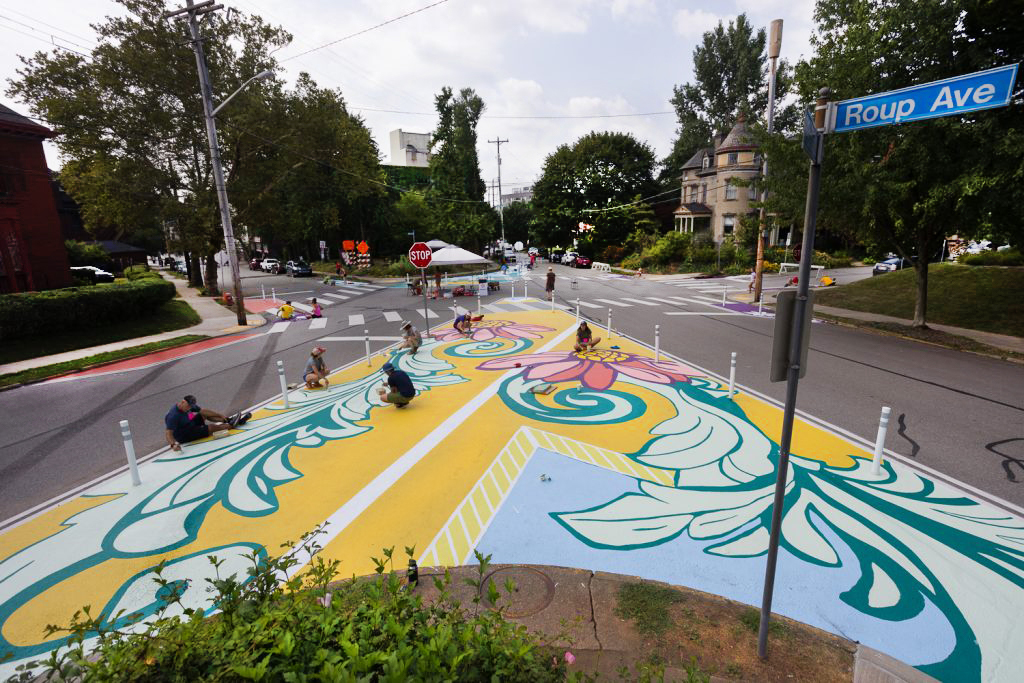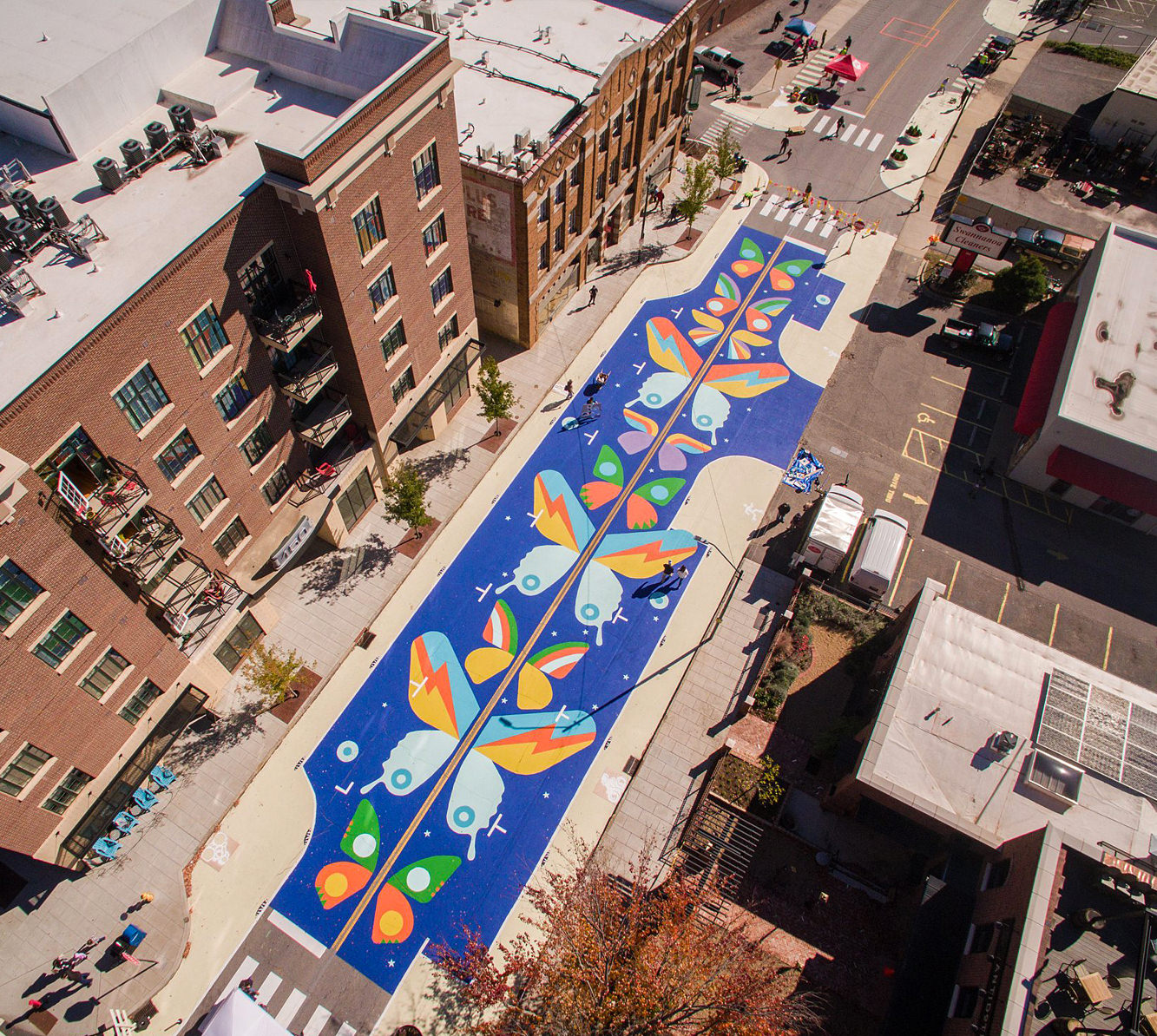Turns out, paint can be protection, at least when it's done right.
Installing asphalt art on roads and intersection can cut crashes between motorists and other road users by a staggering 50 percent, a new study finds — and the experts behind it say its time for policymakers to treat this life-saving traffic-safety treatment as more than just a frill.
In a new report from Bloomberg Philanthropies, researchers analyzed crash rates and driver behavior before and after traffic-calming art projects were added to the 17 U.S. roads and intersections for which the best possible data and imagery was available. Those projects included colorful crosswalks and curb-extending murals that visually shorten a pedestrian's crossing distance, among other innovative designs — and notably, most of them didn't incorporate any other hard-infrastructure improvements at the time they were painted.
Not only did the projects slash crashes involving vulnerable road users in half, they also lessened injury-causing crashes by an average of 37 percent, and cut overall crashes by 17 percent, too. Drivers even yielded to pedestrians in colorful crosswalks 27 percent more often, even though many intersections featured high-visibility paint before.
This is SUCH HUGE NEWS. I used to do a lot of writing about public art and public transit, and there was really such a lack of studies showing something we all know to be true - public art can save liveshttps://t.co/xTOlGZTpZs
— Isabella Segalovich (@isa_segalovich) April 21, 2022
Those stats might seem surprising, given how rare asphalt art is in U.S. cities — and the fact that the Manual of Uniform Traffic Control Devices proposes banning it because of dubious safety concerns.
Many city transportation leaders, however, have touted the benefits of treating the street as a canvas for years, even if those benefits weren't quantified until now.
"When I was commissioner [of the New York City Department of Transportation] under Mike Bloomberg, we built lots of miles of bike lanes and lots of pedestrian spaces and lots of bus lines," said Janette Sadik-Khan, principal at Bloomberg Associates. "But no matter how groundbreaking that work was, it was always unexpected and colorful urban art that really generated the most excitement."
Sadik-Khan stresses that researchers are just beginning to understand the power of public art to transform public safety — and that the cost of trying it is shockingly low.
As part of Bloomberg's larger Asphalt Art Initiative, she and her team have helped install 42 asphalt artworks throughout the U.S. with grants of $25,000 each; one especially effective project in Kansas City, MO, helped cut driver speeds by 45 percent, and helped inspire the safety analysis.
"These projects were never just about pretty pictures," she added. "And cities can deliver these real results for just pennies on the dollar."
Unfortunately, not all transportation professionals regard asphalt art as a smart investment, and some have even questioned whether non-standard markings will confuse drivers — or the autonomous vehicles that someday may replace them.
The most recent proposed edition of the Manual of Uniform Traffic Control Devices — the document which sets the standard for most of the signs, signals and street markings that annotate the right of way— warned against colorful crosswalks, in part, advocates say, because existing AV technology struggles to recognize them as places where people walk. Following tens of thousands of comments from advocates, the manual is undergoing revisions, but its recommendations about asphalt art likely won't be published until 2023.
"It’s probably flipping things to say that we should plan our street designs around AVs rather than design our AVs around streets," said Mike Flynn, national director of transportation planning for the transportation firm Sam Schwartz, which conducted the study.

Flynn says there's more reason to be concerned that low-vision pedestrians won't be able to navigate crosswalks that aren't bright white, and that more study is needed to determine which styles of asphalt art are best at curbing traffic violence among people of varying abilities. Maintaining mobility-enhancing masterpieces is another challenge — especially since cities struggle to repaint even the simplest thermoplastic lane markings when they fade.
Still, he thinks transportation leaders will solve the problems — and it will pay off when they do.
"There’s a reason people have always loved art through human history," Flynn added. "Even if its hard to quantify, it’s real — because otherwise we wouldn’t do it.... And now we've discovered, hey, in certain situations it could also slow down traffic and save lives. For certain policymakers, that’s gonna resonate more than those intangible benefits."

Sadik-Khan also is optimistic that the artist's paintbrush will someday become a bigger part of the transportation-safety tool kit — and an opportunity for DOTs to break down silos and join forces with their local creatives. She says Bloomberg's initiative provides a blueprint that cities around the world can follow, and hopes the safety study will fuel more such art.
"We want to make transformative projects like these as close to plug and paint as possible, because everything in these pages is possible in every city," she added. "Streets really are the ultimate gallery; they're the place where art and life can come together."






